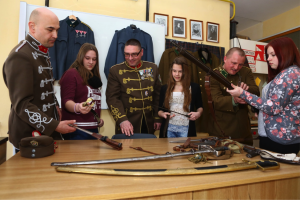by Eva S. Balogh
[Editor’s Update: Coincident with the publication of this post, The Forward published a detailed investigative report by Budapest-based Lili Bayer on Gorka’s ties to anti-Semitic groups in Hungary while he was politically active in that country from 2002 to 2007. It’s a very useful supplement to Prof. Balogh’s account of the history of Vitezi Rend and the Gorka’s family relationship to the group.]
Sebastian Gorka, deputy assistant of President Donald Trump and member of a new White House team, the Strategic Initiatives Group, has been receiving an increasing amount of attention in the last few weeks. Julianne Smith, a former national security adviser to Vice President Joseph Biden, worries about both the existence of this new group and Sebastian Gorka’s presence in it. Counterterrorism experts are particularly concerned about Gorka’s ideas that Islam as a religion cannot be separated from the ideology of terror. Knowledgeable people in the field consider his ideas on Islam dangerous and a radical departure from U.S. policy over the last 17 years.
Several U.S. journalists who have dug into Sebastian Gorka’s past have been puzzled by his proud embrace of his Hungarian roots. Why did he appear at the inaugural ball in a strange braided outfit with an equally strange medallion and decoration? Eli Clifton of LobeLog identified the medallion as one bestowed by the Order of Knights (Vitézi Rend), a group established by Miklós Horthy, regent of Hungary between 1920 and 1944. A day later Allegra Kirkland of Talking Points Memo quoted a Hungarian historian who was less certain about its provenance.
By now we can state with confidence that the medallion is indeed the identifying object of the Order, as Sebastian Gorka himself admitted in a short Breitbart video appearance. He explained that on special occasions he wears the medallion and decoration, which his father received in appreciation of his suffering as a political prisoner between 1950 and 1956. But there is a more complete version of the story that needs telling.
Origins of Vitézi Rend
Miklós Horthy established the Order of Knights to bestow the honor of knighthood on highly decorated World War I veterans. The “captain-general” of the Order was Horthy himself. Although the Order’s leaders today claim that it was always apolitical, they end up describing it as a right-wing, conservative body that promotes Hungary’s military tradition. Unfortunately, this military tradition also includes Hungary’s participation in World War II on the side of Nazi Germany.
Only a few days ago members of the Order marched along with extreme right-wing groups to commemorate the “Day of Honor,” February 11, 1945, when German-Hungarian soldiers in an encircled Budapest tried to break through the Soviet lines. Imre Marosvári, the captain of the Order in Budapest, honored the 72nd anniversary of the event with an unrealistic, pro-German description of the military situation in 1945. The primary concern of these brave soldiers, he said, was to slow down the Soviet advance in order to give the Germans time to develop their “new weaponry.” I assume he is talking about the atomic bomb. He also had harsh words for the Allies. According to him, the American and British air raids were inhumane and cruel and turned the civilian population against the Allies.
The Order still follows its original goals, which among other things aimed “to secure the lordship of the Hungarian race, which could strike down all subversive, anti-national efforts with formidable force.” From its inception the Order was an irredentist organization, whose slogan is still: “I believe in one God, I believe in one country, I believe in the divine everlasting truth, I believe in the resurrection of Hungary,” which means the recreation of Hungary according to its pre-1918 borders. As Hungarian historian Szilárd Tátrai pointed out in a recent article, the ideology and policies of the Order were a faithful reflection of all the key attributes of the Horthy regime. Therefore, nobody should be surprised that the U.S. State Department considered the Order to be an organization under German influence. After all, they argued, Hungary was an ally of Nazi Germany.
The Order was organized along military lines. Under Horthy as captain-general were eight nationwide regional captains. Every county had a captain of its own, and every “járás,” a smaller administrative unit, had a lieutenant. The knight had to observe a strict political and moral code, and unmarried knights had to submit for scrutiny details about their future wives’ families. The male children of knights were required to enroll in the Levente Movement, designed to give military training to Hungarian boys between the ages of 12 and 21. Since the title of knight was inheritable by the oldest male child, the “ideological preparation” of the next generation of knights was considered to be of the utmost importance.
The Order’s Political Associations
Although Hungarians of Jewish extraction were not officially excluded from the Order, in practice they were barred from membership. Here is what Miklós Horthy, the captain-general of the order, had to say on the subject in a letter written in October 1940: “A ‘Vitéz’ may marry with a license only, and persons of alien stock are received only when this person is a 100 per cent Hungarian as to feeling, is reliable and applies himself for the Magyarization of his name. Even the bravest and most decorated Jew is excluded.” Those sentences were followed by Horthy’s infamous claim that “as regards the Jewish problem, I have been an anti-Semite throughout my life. I have never had contact with Jews.”
Although apologists of the Order bring up the couple of high government officials and military men who at the very end turned against the German and Hungarian Nazis, these people were few and far between. Even the official history admits that many knights committed war crimes. For example, “unfortunately the organizers of the bloodbath in Novi Sad (Újvidék) were members of the Order of Knights.” Approximately 3,500 Serbs and Hungarian Jews lost their lives in Novi Sad in 1942. The organizers of this carnage, who thanks to Horthy could await their trial as free men, escaped to Germany only to return with the German troops in 1944. Two men who were instrumental in organizing the transports that carried more than 400,000 Hungarian Jews to their death in 1944 were also knights: László Endre and László Baki.
Horthy died in February 1957 in Estoril, Portugal. But shortly before his death he was still thinking about the future role of the Order, whose “calling is the rebuilding of a new Hungarian future.” With his death, émigré knights began to reorganize the Order, and it soon spread among Hungarians worldwide. The reorganized Order introduced an important change in the admission procedures: heroes of the 1956 Hungarian Revolution could also become knights. Because of this new policy (loosely interpreted), Sebastian Gorka’s father, Pál Gorka, became eligible for admission to the Order of Heroes. His investiture, in 1979, apparently took place in Great Britain, to which he had escaped after the defeat of the uprising by Soviet troops.
Today there is not one Order of Knights but two because the leaders of the organizations are badly split on several issues. One group is called “Vitézi Red” (Order of Knights) while the other is known as “Történelmi Vitézi Rend” (Historical Order of Knights). The split occurred after the center of the Order moved back to Hungary. Pál Gorka and most likely Sebastian Gorka as well were invested in the Historical Order of Knights led by László Hunyadi, its captain-general.

The knights show off the paraphilia to young girls. The officer’s uniform on the right is a copy of those used by the Hungarian Army before 1945.
Gorka’s Connection to the Order
As for Pál Gorka and his knighthood, I have pieced together his story from bits of information that he and his son provided. The stories, I’m afraid, don’t always jibe. The elder Gorka was arrested in 1950, but the duration of his sentence is not at all clear. When Pál Gorka was interviewed by David Irving, the well-known Holocaust denier, for his book on the Hungarian revolution of 1956, he claimed that he had been sentenced to life imprisonment for espionage because “one of his cell’s couriers was shot on the frontier, and papers found on him enabled the AVH [the Hungarian state security] to break the network.” However, in a Hungarian-language article that appeared in August 2002, he said that he had received a ten-year sentence and that Kim Philby, the notorious British spy, had betrayed him and his comrades.
In that same 2002 interview Pál Gorka also talked about his part-time work for the British government. For 30 years he helped the authorities vet newly arrived political refugees from Hungary. He seems to have been active in the local Hungarian community. For example, he represented the British-Hungarian community in the World Federation of Hungarians and in that capacity attended the Third World Congress of the Federation in Budapest in 1992.
Another intriguing aspect of the Gorka family’s life in Great Britain is their relationship to David Irving, a revisionist historian who tried to clean away the “years of grime and discoloration from the façade of a silent and forbidding monument” to reveal the real Hitler. His 1977 book, Hitler’s War, tried to whitewash Hitler while blaming the allies for escalating the war. Irving was prolific, coming out with a new book practically every year. Eventually, he decided to write a book on the 1956 Hungarian Revolution, which he published in 1981 under the title Uprising! One Nation’s Nightmare, 1956. The massive 740-page book is available online. Irving’s conclusion is that the revolt was “primarily an anti-Jewish uprising,” a gross misrepresentation of the facts. He interviewed a lot of people both in Hungary and abroad who had a role to play in the events. Although Pál Gorka, who had been freed from jail a few days after the outbreak of the uprising, certainly wasn’t a key player, he got at least a couple of footnotes. More interesting was the introduction where Irving thanked his three interpreters, one of whom was Susan Gorka, Pál’s wife and Sebastian’s mother. Considering that Irving, according to his own admission, spent about six years off and on doing research on this book and knew not a word of Hungarian, Susan Gorka must have worked with the author fairly closely.
Returning to the issue of the medallion, I would like to correct Sebastian Gorka’s somewhat misleading description of how his father acquired the medallion. The medallion is not bestowed by the Order in recognition of some heroic deed. It is tangible proof of membership in the Order. A person must apply for membership and must be approved by the leadership of the Order. Presumably, Pál Gorka was approved because he was a “hero” of 1956 who adhered to the precepts of the Order. Moreover, once a person undergoes the process of investiture he is expected to be an active participant in the organization. Pál Gorka was probably an active member of the organization when the Gorkas lived in Great Britain. He was certainly active after his return to Hungary. He and his wife settled in Sopron, a town close to the Austrian border, where he worked on behalf of the Order under Kornél Pintér, “territorial tribe captain” of the region. In the last ten years of his life he served as “knight lieutenant” on the county level.
According to the rules of the Order, inheritance of the title is not automatic. The eldest son must be approved by the Board of the Order. One cannot just “inherit” the medallion and use it “in memory” of one’s father. If we can believe Kornél Pintér, the “tribe captain,” Sebastian is a full-fledged member of the Order in his own right. That’s why Pintér is so proud that “one of our fellow members is now in the White House.”
Eva S. Balogh is emeritus professor of history and former dean of Morse College at Yale University. She fled Hungary in 1956 as a university student and currently maintains an important English language daily blog, Hungarian Spectrum. The blog has a wide international following, is frequently cited in international publications such as The Economist and The Wall Street Journal, and is archived at the Library of Congress.





